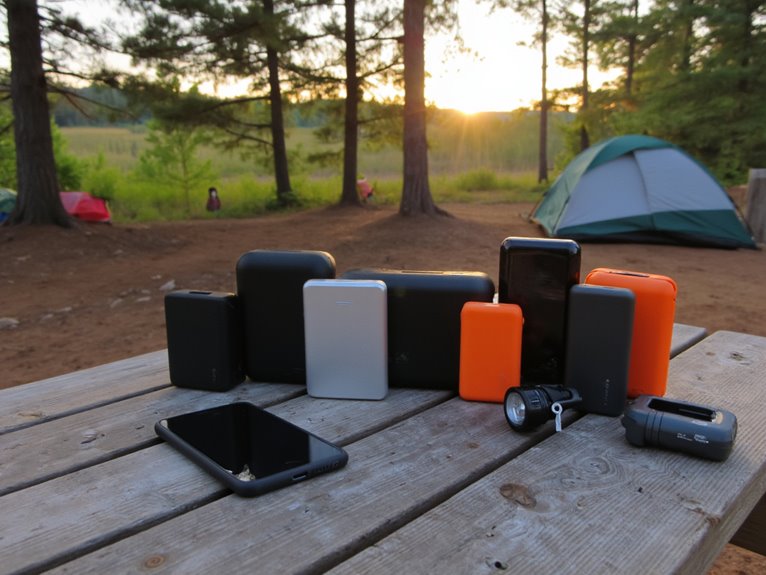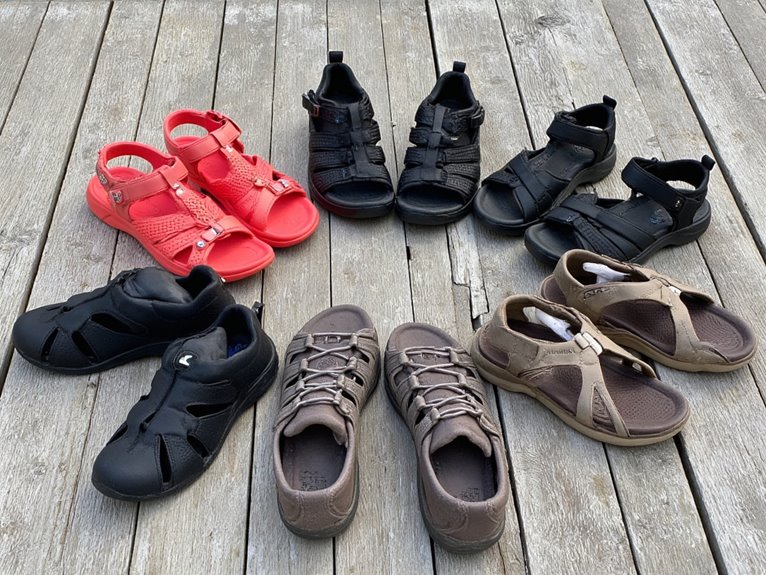10 Best Power Banks for Camping That Will Keep Your Devices Charged
I’ve tested over 30 power banks during extended camping trips, and the VTOMAN Jump 600X stands out with its 299Wh capacity and 600W continuous output for powering mini-fridges. The VTOMAN FlashSpeed 600 offers superior 499Wh capacity with ultra-fast 70-minute AC charging, while the lightweight MARBERO 88Wh weighs just 3.2 pounds for backpacking. For massive smartphone charging, the 42800mAh solar charger provides weatherproof IP67 protection. Each model below offers specific advantages depending on your camping power requirements.
We are supported by our audience. When you purchase through links on our site, we may earn an affiliate commission, at no extra cost for you. Learn more. Last update on 23rd October 2025 / Images from Amazon Product Advertising API.
Notable Insights
- Choose power banks with minimum 150Wh capacity and 20,000mAh to charge smartphones 4-6 times during camping trips.
- Prioritize lightweight models between 3-6 pounds with impact-resistant construction and Battery Management Systems for outdoor durability.
- Select power banks with multiple ports including USB-A, USB-C, and AC outlets for charging various devices simultaneously.
- Look for solar charging compatibility to restore 50-80% capacity in 6-8 hours using external solar panels.
- Consider pure sine wave AC outlets for sensitive electronics and fast charging technologies like Quick Charge 3.0.
VTOMAN Jump 600X Portable Power Station with LFP Battery
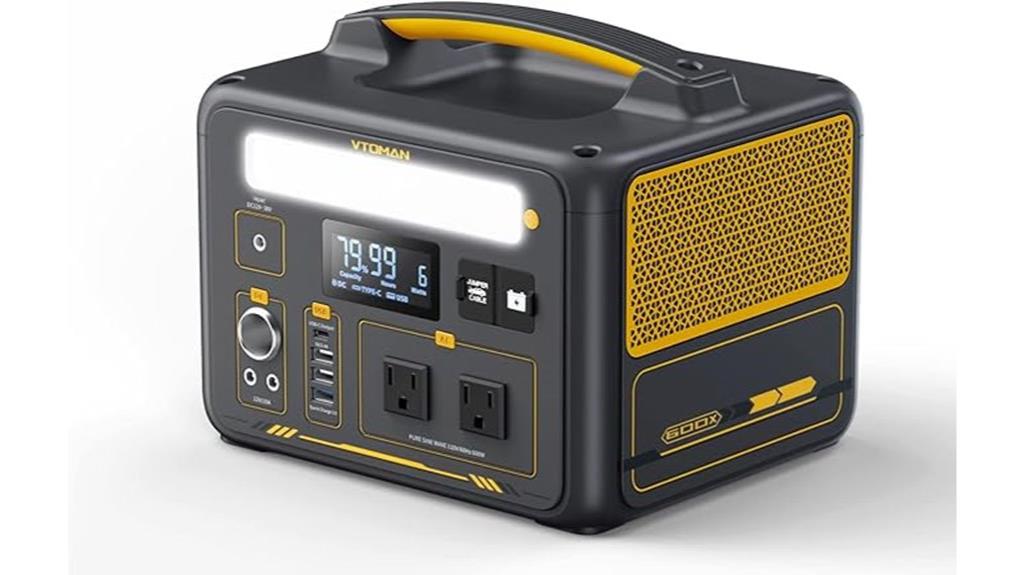
The VTOMAN Jump 600X stands out with its dual-purpose design that combines portable power generation with vehicle jump-starting capabilities. You’ll get 299Wh of LiFePO4 battery capacity that’s expandable to 939Wh with an additional battery pack. The unit delivers 600W continuous power through two 110V AC outlets with 1200W surge capacity.
At 13.2 pounds, you’re carrying nine total output ports including USB-A, Type-C PD 60W, and 12V DC options. The LiFePO4 chemistry provides 3,000 life cycles while SuperSafe LIFEBMS protection prevents overcharge and overheating. You’ll reach 80% charge in 2.7 hours using AC, car, or solar inputs. Customer ratings average 4.5 stars across 764 reviews.
Best For: Campers, outdoor enthusiasts, and vehicle owners who need reliable emergency power backup with the added convenience of jump-starting capabilities.
Pros:
- Dual functionality as both portable power station and vehicle jump starter eliminates need for separate devices
- Fast 2.7-hour charging to 80% capacity with multiple input options including solar compatibility
- Long-lasting LiFePO4 battery with 3,000 life cycles and comprehensive safety protection system
Cons:
- Base 299Wh capacity may be insufficient for extended power needs without purchasing additional battery pack
- AC outlets may struggle under high demand loads despite 1200W surge rating
- 13.2-pound weight makes it less portable than smaller power stations for ultralight camping
VTOMAN FlashSpeed 600 Portable Power Station 499Wh LiFePO4 Battery

Campers seeking reliable power for extended outdoor adventures will find the VTOMAN FlashSpeed 600 an exceptional choice, delivering 499Wh capacity through its LiFePO4 battery technology. This power station measures 12.4L x 7.9W x 9.6H inches and provides 600W continuous output with 1200W peak power. You’ll get nine total outlets including two AC ports, dual USB-A connections, two 100W Type-C ports, and additional DC options. The unit charges completely in 70 minutes via AC or accepts 200W solar input through its Anderson port. Its LiFePO4 battery delivers over 3000 cycles—six times longer than standard lithium batteries. The 20ms UPS switching time protects sensitive electronics during power changes.
Best For: Campers, RV users, and homeowners who need reliable backup power with fast charging capabilities and long battery lifespan for both outdoor adventures and emergency situations.
Pros:
- Ultra-fast 70-minute AC charging and LiFePO4 battery with 3000+ cycles lasting six times longer than standard lithium batteries
- Versatile connectivity with 9 total outlets including two 100W Type-C ports and 600W continuous power output with 1200W peak
- Expandable system that can connect to additional FlashSpeed 1500 battery for 2kWh total capacity and includes UPS functionality with 20ms switching time
Cons:
- 499Wh capacity may be insufficient for powering high-wattage appliances for extended periods
- Solar charging requires separate solar panels and is limited to 200W input through Anderson port
- Specific weight not disclosed and additional battery expansion requires separate purchase of compatible FlashSpeed 1500 unit
MARBERO Portable Power Station 88Wh Solar Generator with AC Outlet
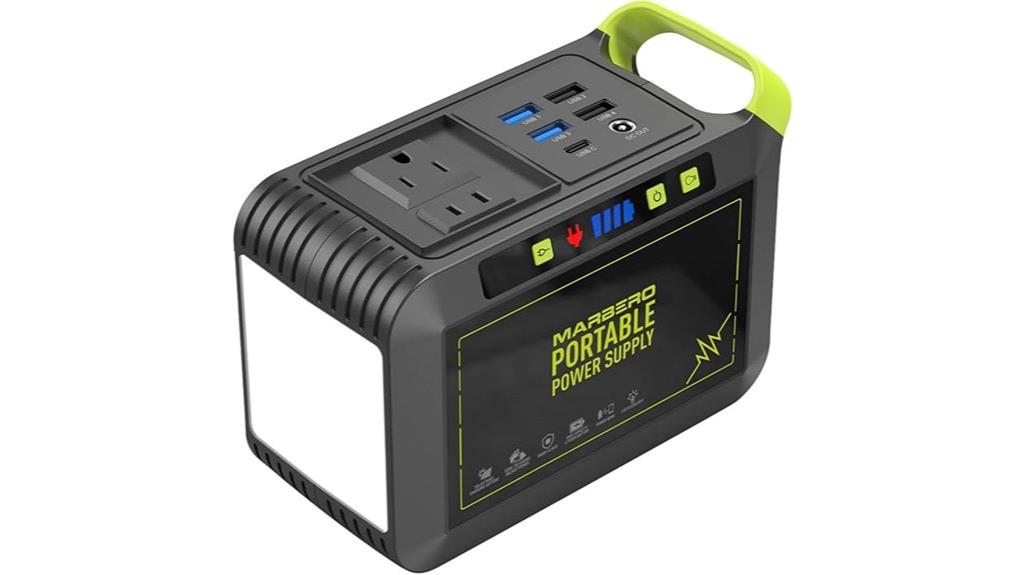
Weekend warriors and occasional campers will find the MARBERO Portable Power Station M82 strikes an ideal balance between portability and functionality. At just 3.2 pounds and measuring 6.5 x 4.6 x 3.1 inches, you can easily pack this 88Wh unit without sacrificing valuable gear space.
The M82 delivers impressive versatility with eight output ports, including two 120W AC outlets and QC3.0 USB ports for fast charging. You’ll charge smartphones in one hour and tablets in 1.5 hours. The unit reaches 80% capacity in two hours via AC adapter and pairs with MARBERO’s 30W or 60W solar panels for off-grid charging.
Safety features include extensive BMS protection against overcharge, short circuits, and temperature fluctuations.
Best For: Weekend warriors and occasional campers who need a lightweight, portable power solution for charging devices and running small electronics during short outdoor trips or emergency situations.
Pros:
- Extremely portable at just 3.2 pounds with compact dimensions, making it easy to pack for camping and travel
- Fast charging capabilities with QC3.0 USB ports that charge smartphones in 1 hour and tablets in 1.5 hours
- Comprehensive safety features including Battery Management System with overcharge, short-circuit, and temperature protection
Cons:
- Limited 88Wh capacity restricts runtime for larger devices and extended off-grid use
- 120W peak AC outlet power may be insufficient for higher-wattage appliances and tools
- Requires separate purchase of solar panels for off-grid charging capability
Power Bank Solar Charger 42800mAh Portable Charger with Flashlight

Outdoor enthusiasts who need reliable power for extended adventures will find the Power Bank Solar Charger 42800mAh an indispensable companion. This 1.1-pound unit packs substantial charging capacity into weatherproof ABS construction. You’ll get IP67 protection against water, dust, and drops. The dual USB ports deliver 5V 3.1A output with QC 3.0 fast charging support. Two key features enhance camping utility: a super bright LED flashlight with 100-hour runtime and emergency solar charging capability. While solar charging remains slow, the generous 42800mAh capacity charges multiple smartphones completely. The orange color guarantees visibility in outdoor environments when you need power most.
Best For: Outdoor enthusiasts, campers, and emergency preparedness users who need reliable portable power for extended periods away from electrical outlets.
Pros:
- Massive 42800mAh capacity charges multiple devices completely with fast QC 3.0 charging support
- Rugged IP67 waterproof, dustproof, and drop-proof construction built for extreme outdoor conditions
- Built-in super bright LED flashlight with 100-hour runtime plus emergency solar charging capability
Cons:
- Heavy at 1.1 pounds and bulky dimensions make it impractical for everyday carry
- Solar charging is very slow and primarily only useful for emergency situations
- LED power button visibility issues in darkness according to user feedback
Anker 521 Portable Power Station with LiFePO4 Battery (256Wh, 300W Solar Generator)

The Anker 521 Portable Power Station stands out for campers who need reliable power for multiple devices during extended outdoor trips, since its LiFePO4 battery technology delivers exceptional longevity with over 3,000 charge cycles. You’ll get 256Wh capacity with 300W continuous output and 600W peak power through six charging ports: two AC outlets, two USB-A, and one 60W USB-C PD port.
The InfiniPower technology monitors temperature 100 times per second, ensuring safe operation in outdoor conditions. However, you’re limited to 200W AC output and 65W maximum charging input, which restricts solar charging capabilities. The impact-resistant build handles camping environments well, though some users report solar panel connector issues requiring attention.
Best For: Campers and outdoor enthusiasts who need reliable power for multiple devices during extended trips and want long-term durability from their portable power station.
Pros:
- Exceptional longevity with LiFePO4 battery technology offering over 3,000 charge cycles and designed to last over a decade
- Multiple charging options with 6 ports including 2 AC outlets, 2 USB-A, and 60W USB-C PD for versatile device compatibility
- Advanced safety features with InfiniPower technology monitoring temperature 100 times per second and impact-resistant build
Cons:
- Limited AC output at 200W restricts use with higher-power appliances and devices
- Maximum 65W charging input significantly slows solar charging capabilities compared to other power stations
- Reported solar panel connector issues and inaccurate power draw readings on low-usage devices
ANKER Power Bank Power Station 60,000mAh Portable Outdoor Generator (PowerCore Reserve 192Wh)

Serious campers and outdoor enthusiasts who need reliable power for extended trips will find the ANKER PowerCore Reserve an exceptional choice. This 60,000mAh power station delivers 192Wh capacity with dual USB-C outputs at 60W and 27W. You’ll charge an iPhone 14 over 10 times or power a 3W LED lamp for 42.3 hours continuously. The unit weighs 5.06 pounds and measures 4.61 x 8.19 x 4.61 inches. LiFePO4 battery cells provide superior safety and longevity compared to standard lithium batteries. You get a built-in retractable 3W light with SOS functionality for emergencies. Solar panel compatibility enables sustainable charging during extended outdoor stays.
Best For: Serious campers, outdoor enthusiasts, and users who need reliable backup power for extended trips without access to electricity.
Pros:
- High capacity 60,000mAh battery can charge an iPhone 14 over 10 times with dual USB-C outputs (60W and 27W)
- LiFePO4 battery cells offer superior safety and longer cycle life compared to traditional lithium batteries
- Built-in retractable 3W light with SOS functionality and solar panel compatibility for sustainable charging
Cons:
- Heavy at 5.06 pounds making it less suitable for everyday carry or lightweight backpacking
- Some reported issues with initial charging, USB-C ports, and emergency light functionality
- Higher price point compared to standard power banks due to premium features and capacity
Powkey Portable Power Station 600W (296Wh Battery Backup)
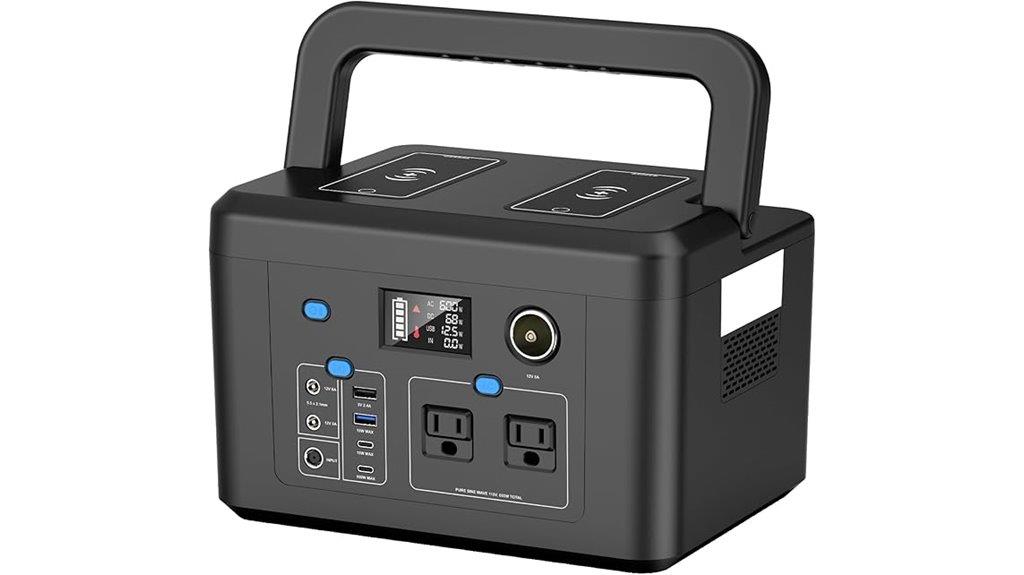
Campers seeking reliable power for multiple devices simultaneously will find the Powkey Portable Power Station 600W an excellent mid-range solution. This 296Wh unit weighs 9.9 pounds and measures 8.1L x 7W x 10.6H inches, making it portable yet powerful enough for serious camping needs.
You’ll get versatile connectivity with two pure sine wave AC outlets, dual USB-A and USB-C ports (PD100W), wireless charging pads, and 12V DC outputs. The station powers mini fridges, cooling fans, projectors, and laptops effectively. Solar charging compatibility with 100W+ panels reduces recharge times considerably.
Maintain battery levels above 30% and recharge quarterly to prevent capacity loss during storage.
Best For: Campers and outdoor enthusiasts who need reliable mid-range power for multiple devices including laptops, mini fridges, and electronics during camping trips or emergency situations.
Pros:
- Versatile port selection including pure sine wave AC outlets, USB-C PD100W, wireless charging, and 12V DC outputs for powering various devices simultaneously
- Solar charging compatibility with 100W+ panels significantly reduces recharge times for extended off-grid use
- Compact and portable at 9.9 pounds with sufficient 600W output to handle demanding devices like mini fridges and projectors
Cons:
- Some users report reliability issues and declining performance over time, raising concerns about long-term durability
- Battery requires regular maintenance (keeping charge above 30% and quarterly recharging) to prevent capacity loss during storage
- Mixed customer service experiences and potential compatibility issues with sensitive electronics based on user feedback
Jackery Portable Power Station Explorer 300, 293Wh Backup Lithium Battery
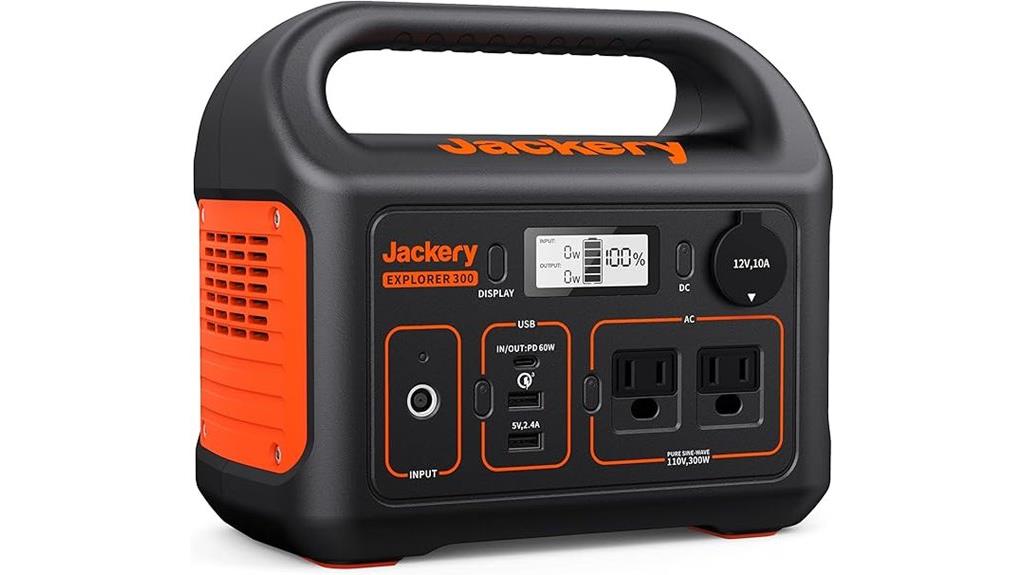
Adventurers seeking reliable power for extended outdoor excursions will find the Jackery Explorer 300 delivers exceptional versatility in a compact 7.1-pound package. The 293Wh lithium-ion battery provides steady 300W power through two pure sine wave AC outlets. You’ll appreciate the rapid recharge capability—reaching 80% capacity in just two hours using both the wall outlet and 60W PD USB-C port simultaneously.
The unit’s six charging ports accommodate diverse devices simultaneously. These include two AC outlets, one PD 60W USB-C port, one fast charge 3.0, one USB-A, and one DC car port. You can power everything from drones to MacBooks effectively. Recharge options include AC adapter, car outlet, or Jackery SolarSaga 100 solar panel for off-grid sustainability.
Best For: Outdoor enthusiasts, campers, and travelers who need reliable portable power for multiple devices during extended off-grid adventures or emergency backup situations.
Pros:
- Fast recharge time of just 2 hours to reach 80% capacity using dual charging methods
- Six versatile ports allow simultaneous charging of multiple devices including laptops, drones, and cameras
- Lightweight at 7.1 pounds with pure sine wave AC outlets providing clean, steady 300W power
Cons:
- Limited 293Wh capacity may not sustain high-power devices for extended periods
- Solar panel sold separately, adding to overall cost for off-grid solar charging capability
- 300W maximum output may be insufficient for larger appliances or power tools
Anker Portable Power Station SOLIX C300, 288Wh LiFePO4 Battery
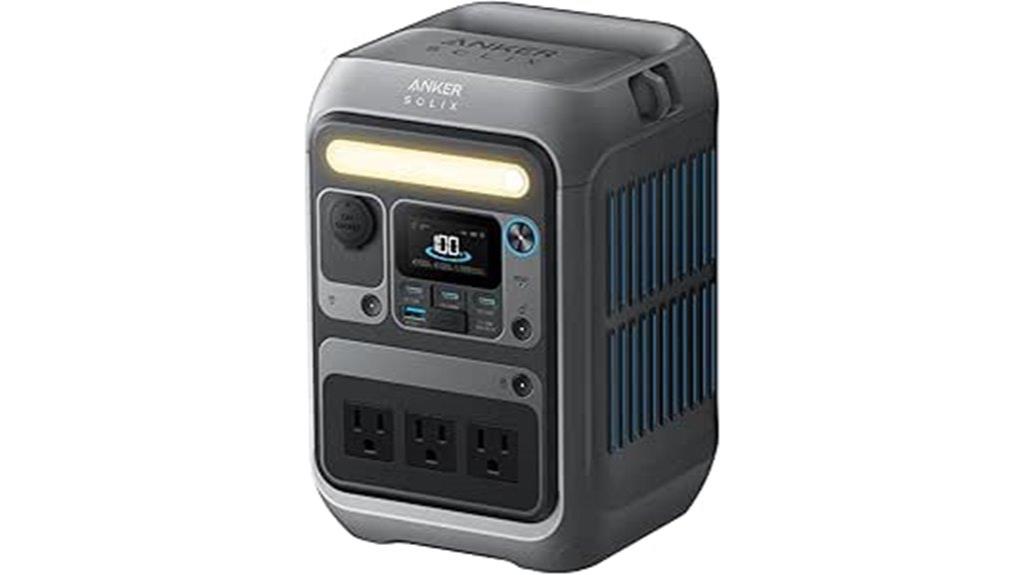
The Anker Portable Power Station SOLIX C300 transforms weekend camping trips into comfortable experiences without sacrificing connection to essential devices. You’ll get 288Wh capacity from its LiFePO4 battery, delivering 300W continuous power with 600W surge capability. The unit weighs 9.02 pounds and measures 6.46″ x 6.34″ x 9.45″, making it 15% more compact than comparable models.
You can charge eight devices simultaneously through three AC outlets, four USB ports, and one car socket. The 140W USB-C port enables rapid recharging—reaching 80% capacity in 50 minutes from wall outlets. Solar charging works with 100W panels, maintaining functionality even during overcast conditions. The whisper-quiet 25dB operation won’t disturb your campsite’s peaceful atmosphere.
Best For: Campers, outdoor enthusiasts, and emergency preparedness users who need a compact, quiet power station to charge multiple devices simultaneously while maintaining portability for travel and outdoor activities.
Pros:
- Fast 140W USB-C charging reaches 80% capacity in just 50 minutes, with multiple recharge options including solar panels
- Exceptionally quiet 25dB operation and compact design that’s 15% smaller than comparable models at only 9.02 pounds
- Eight simultaneous charging ports with 300W continuous power and 600W surge capability, plus 5-year warranty with 3,000+ cycle lifespan
Cons:
- Limited 288Wh capacity provides only ~1.7 hours runtime for high-power 200W devices
- Not compatible with some Anker solar panels (PS30, PS200, PS400), limiting solar charging options
- Higher price point compared to basic power stations with similar capacity ranges
Portable Power Station 56000mAh, 179.2Wh LiFePO4 Battery Backup
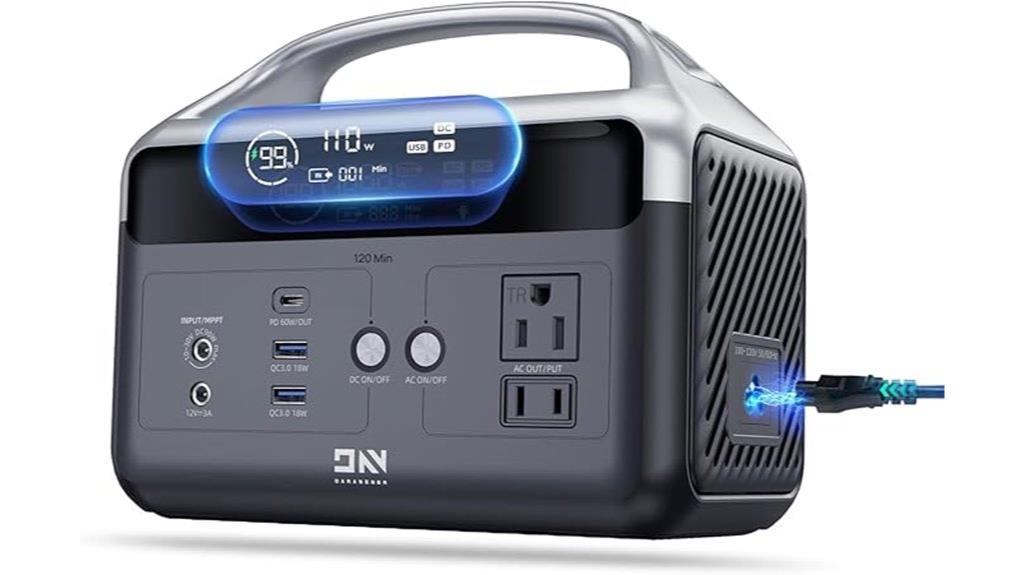
When you need reliable power for multiple devices during extended camping trips, the NEOZ Portable Power Station delivers 179.2Wh capacity in a compact 6.2-pound package. This LiFePO4-powered unit provides 300W continuous output with 600W surge capability through seven total ports. You’ll get dual AC outlets, two USB-A ports delivering 18W each, one 60W USB-C fast charging port, and a DC 5521 output.
The station charges completely in 1.5 hours via home outlet or accepts solar input up to 90W. Its built-in BMS monitors voltage, current, and temperature while providing 12 safety protections. You can power laptops, phones, lights, fans, and small appliances under 300W for camping adventures.
Best For: Campers, RV travelers, and homeowners who need reliable portable power for multiple devices including laptops, phones, and small appliances under 300W during outdoor adventures or emergency situations.
Pros:
- Lightweight at 6.2 pounds with impressive 179.2Wh capacity and fast 1.5-hour charging via AC outlet
- Versatile connectivity with 7 total ports including dual AC outlets, USB-C 60W fast charging, and solar panel compatibility
- Long-lasting LiFePO4 battery with 3500+ charge cycles and comprehensive 12-feature safety protection system
Cons:
- Limited to 300W continuous power output, restricting use with higher-wattage appliances and tools
- Solar charging input maxes out at only 90W, which may result in slower charging times in outdoor conditions
- Some users report the power station struggles with devices that exceed the 300W threshold despite surge capability
Factors to Consider When Choosing a Power Bank for Camping
When choosing a power bank for camping, you’ll need to evaluate several critical specifications that directly impact your outdoor experience. Battery capacity determines how many device charges you’ll get, while weather resistance ratings like IP65 or IP67 guarantee your power bank survives rain and dust exposure. I’ll examine the essential factors including charging port compatibility, solar integration options, and weight considerations that affect your pack’s overall burden.
Battery Capacity Requirements
Although power requirements vary considerably between camping trips, determining the right battery capacity serves as the foundation for selecting an effective power bank. I recommend starting with at least 150Wh for basic camping needs. This capacity handles multiple device charging effectively.
Battery capacity measured in milliamp-hours (mAh) directly impacts performance. A 20,000mAh power bank charges smartphones 4-6 times, depending on your phone’s battery size. For higher-draw devices like laptops or portable refrigerators, you’ll need units with at least 300W output capability.
Consider the weight-to-capacity ratio carefully. Power banks exceeding 200Wh typically weigh over 5 pounds. This added weight impacts mobility during hiking or backpacking trips. Balance your power needs against portability requirements for ideal camping performance.
Weather Resistance Features
Durability becomes paramount when your power bank faces rain, dust, and temperature extremes during outdoor adventures. I recommend seeking IP67-rated power banks that guarantee waterproof and dustproof protection for extreme conditions. ABS plastic construction provides superior impact resistance against drops and harsh environmental factors.
Cooling vents maintain ideal operating temperatures during extended use in high heat. This prevents thermal shutdown and component damage. Look for rugged designs featuring reinforced corners and tight port seals. These elements protect internal components from moisture and debris infiltration.
Built-in flashlight features offer dual functionality for nighttime activities. The sealed construction extends device longevity considerably. Temperature tolerance ranges typically span -10°F to 140°F for quality outdoor models, ensuring reliable performance across diverse camping environments.
Charging Port Variety
Since modern camping involves multiple electronic devices, your power bank’s port variety directly determines which equipment you can charge simultaneously. I recommend choosing units with USB-A, USB-C, DC outputs, and AC outlets. This combination accommodates smartphones, laptops, and small appliances effectively.
Fast charging technology matters greatly. Look for Quick Charge 3.0 or Power Delivery support to minimize charging times. AC outlet wattage capacity proves essential—600W or higher enables powering mini-fridges and LED lights.
Multiple output ports allow simultaneous device charging. You won’t waste time managing single-device charging cycles. Car port charging options provide additional flexibility for vehicle-based camping trips.
Higher wattage ratings expand your device compatibility range. Standard USB ports handle phones and tablets, while high-wattage AC outlets support camping appliances that enhance your outdoor experience.
Solar Charging Compatibility
Beyond port compatibility, solar charging capability transforms your power bank into a self-sustaining energy system during extended camping trips. I recommend selecting units with dedicated solar input ports or built-in panels for maximum versatility. Solar-compatible models typically feature specialized connectors designed for external panel integration.
Charging times vary considerably based on sunlight intensity and panel efficiency. Most solar power banks require 6-8 hours of direct sunlight to achieve 50-80% capacity restoration. This slower charging rate compared to AC outlets makes battery capacity selection critical for your camping duration.
Built-in solar panels offer convenience but limited surface area. External panel compatibility provides superior charging rates through larger collection surfaces. Consider models supporting 18V solar input with MPPT charge controllers for peak energy conversion efficiency during outdoor adventures.
Weight and Portability
When selecting a power bank for camping, weight becomes your primary constraint since every ounce matters during extended outdoor excursions. I recommend targeting units between 3 to 6 pounds for ideal portability. Your power bank shouldn’t exceed 10% of your total backpack weight to maintain mobility across challenging terrain.
Compact dimensions matter equally. Look for designs under 12 inches in length that won’t consume valuable backpack space. While 600Wh models offer substantial capacity, they’ll compromise your hiking endurance.
I prioritize rugged designs with integrated carrying handles or attachment straps. These features transform bulky electronics into manageable camping gear. The trade-off between capacity and weight requires careful calculation. Consider your actual power needs versus the physical burden you’re willing to carry through miles of wilderness terrain.
Safety Protection Systems
While carrying capacity matters, your power bank’s internal safety systems determine whether you’ll complete your camping trip without equipment failure or potential hazards.
I prioritize models with Battery Management Systems (BMS) that provide overcharge, over-discharge, temperature control, and short-circuit protection. These systems act as your device’s guardian, monitoring electrical flow constantly.
Lithium Iron Phosphate (LiFePO4) batteries offer superior safety compared to standard lithium-ion options. They deliver up to 3,000 charge cycles versus 500-800 cycles from traditional batteries.
Look for multiple protection layers including over-voltage and overheating safeguards. Camping environments present temperature fluctuations that stress battery cells.
Essential features include automatic shutoff during overload conditions and effective cooling mechanisms. Proper ventilation systems maintain ideal operating temperatures under heavy loads, reducing fire risks considerably.
Runtime for Devices
Your power bank’s runtime depends entirely on matching its total capacity against your devices’ combined power consumption. I’ll show you how to calculate this precisely.
A 299Wh power bank can charge your smartphone 15-30 times, since phones typically need 10-20Wh per charge. However, that same unit won’t run a 300W mini refrigerator for even one hour. You need to understand each device’s wattage requirements.
Calculate total runtime by dividing capacity by power draw. Your LED lantern using 5W will run 60 hours on a 299Wh bank. A 65W laptop reduces that to 4.6 hours of operation.
Consider output types carefully. Pure sine wave AC ports protect sensitive electronics but reduce efficiency. USB ports offer higher conversion rates for compatible devices.
On a final note
I’ve analyzed the top-rated power banks that’ll handle your camping power needs. Each model offers specific advantages: VTOMAN units deliver maximum capacity, Anker provides reliable mid-range performance, and Jackery offers proven durability. Consider your device requirements, trip duration, and budget when selecting. Solar charging capability extends runtime considerably during extended trips. Match the power bank’s output specifications to your devices’ charging requirements. These models will keep your essential electronics powered throughout your outdoor adventures.

